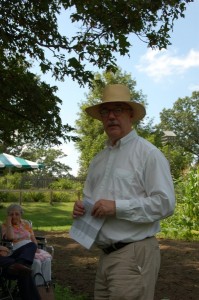Photo gallery
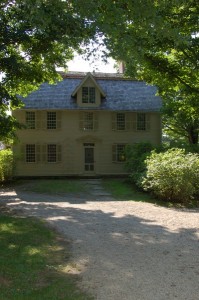 It is believed that the garden at the Old Manse was a wedding present from Henry David Thoreau to Nathaniel Hawthorne and his wife Sophia Peabody Hawthorne. Planted in 1842, it has been a continuously cultivated garden for nearly 170 years!
It is believed that the garden at the Old Manse was a wedding present from Henry David Thoreau to Nathaniel Hawthorne and his wife Sophia Peabody Hawthorne. Planted in 1842, it has been a continuously cultivated garden for nearly 170 years!
I attended the garden tour, talk and afternoon tea at the Old Manse in Concord with a friend on yet another beautiful summer afternoon. Hasn’t the weather been glorious this summer?
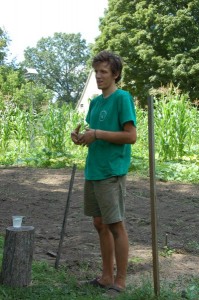 Alec Ellsworth, a young farmer who is in charge of the Old Manse garden, along with Prentis Crosier, a guide and historian at the Old Manse, together led the talk and discussion about the history and current running of the farm.
Alec Ellsworth, a young farmer who is in charge of the Old Manse garden, along with Prentis Crosier, a guide and historian at the Old Manse, together led the talk and discussion about the history and current running of the farm.
Prentis told us that Hawthorne and his wife came directly to the Old Manse on July 9th in 1842 from their wedding in Boston. Given that Hawthorne was one of the leaders in the Transcendentalist movement, which promoted the idea of living in harmony with nature, a garden was the perfect wedding gift.
 In 1843, Hawthorne expanded the garden to a quarter of an acre. He grew vegetables while
In 1843, Hawthorne expanded the garden to a quarter of an acre. He grew vegetables while
Sophia focused on the flowers. The vegetables grown here were typical of what is still grown in New England: corn, potatoes, squash, pumpkins, beans, turnips, leeks, beets, carrots, melons, and herbs. Most unusual for that time, Hawthorne also grew tomatoes, which was generally believed to be poisonous, possibly because it is a member of the nightshade family.
The corn, squash, and beans were, and still are, grown together following the tradition of the Native Americans. The beans supply nitrogen to the soil, while the corn provides support for the beans and shade for the squash.
He also grew rhubarb and asparagus. In the mid 1800s, Concord was an agricultural center with rhubarb and asparagus being its main crops.
The Manse garden could feed eight families during the growing season from April to October, or four families for the whole year if the root vegetables were stored over the winter.
Today, most of the vegetables grown in the garden are heirloom varieties such as “Bloody Butcher” corn and “Cherokee Trail of Tears” beans. They also grow crops from hybrid seed mainly as part of their participation in the organization Gaining Ground, which is a farm based at the Thoreau Birthplace Property in Concord. It is a training ground for young farmers and supplies produce to local food pantries and food programs with the help of many volunteers.
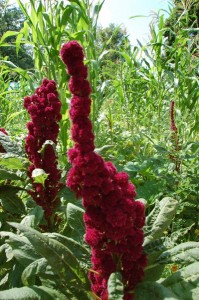 Sophia grew flowers typical for this area: dahlias, zinnias, morning glories, Black-eyed Susans, statice, and nasturtiums. She also grew a few varieties of amaranth including “Love Lies Bleeding”. Did you know that amaranth is the most widely grown plant in the world? Apparently, it’s harvested for its nourishing grain.
Sophia grew flowers typical for this area: dahlias, zinnias, morning glories, Black-eyed Susans, statice, and nasturtiums. She also grew a few varieties of amaranth including “Love Lies Bleeding”. Did you know that amaranth is the most widely grown plant in the world? Apparently, it’s harvested for its nourishing grain.
The farm at the Old Manse also includes fruit trees. In Hawthorne’s time, there were apple, pear, peach, cherry, and currant trees. Today, all but cherry trees still grow here.
Hawthorne thought of the Manse as Eden with he and his wife as Adam and Eve. He would visit the garden a dozen times a day in the course of his writing. A place to soothe the soul and to inspire the spirit, I would imagine.
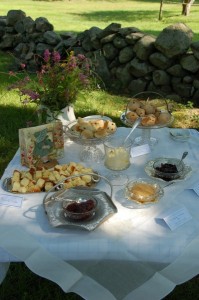 After the talk, a proper English afternoon tea was served complete with dainty crustless sandwiches, salad, scones, cookies, fruit, clotted cream, lemon curd, jam, and of course tea, both iced and hot. The site manager, Tom Beardsley, who is originally from Yorkshire, England, assured us that this was in the tradition of teas served by his mother and his aunt when he was growing up. So it was quite authentic. The tea was prepared and coordinated by a volunteer, Susan Adam, with the help of other volunteers. She laid the tables with some very nice French Limoges porcelain china that had been in storage at the Old Manse.
After the talk, a proper English afternoon tea was served complete with dainty crustless sandwiches, salad, scones, cookies, fruit, clotted cream, lemon curd, jam, and of course tea, both iced and hot. The site manager, Tom Beardsley, who is originally from Yorkshire, England, assured us that this was in the tradition of teas served by his mother and his aunt when he was growing up. So it was quite authentic. The tea was prepared and coordinated by a volunteer, Susan Adam, with the help of other volunteers. She laid the tables with some very nice French Limoges porcelain china that had been in storage at the Old Manse.
The Old Manse will be offering another garden tour, talk, and afternoon tea event in September. Call the Old Manse at 978-369-3909 for more information and to make reservations.
The Old Manse is located near the entrance to the Old North Bridge, which is part of the Minuteman National Park. You can also spend several days visiting other sites in Concord such as Orchard House, the Wayside, Sleepy Hollow Cemetery, the Concord Museum, and Walden Pond. Here you will learn about other writers and founders of the Transcendentalist movement including Ralph Waldo Emerson, Henry David Thoreau, and Louisa May Alcott and her father Bronson Alcott.
For more information, visit the following websites:
Old Manse
Orchard House
The Old North Bridge and the Wayside
Concord Museum
Sleepy Hollow Cemetery
Walden Pond

